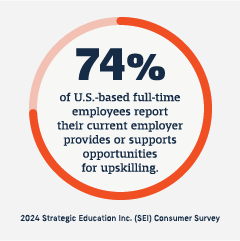- Professional growth: Building job-relevant skills keeps employees at the forefront of their fields. Examples could include technical training or education programs.
- Personal growth: Capabilities such as communication, collaboration, and emotional intelligence can help employees become more well-rounded.
- Career progression: This could include upward promotion or lateral moves that expand an employee’s skills.
- Engagement, satisfaction, and retention: When employers support growth, it can boost retention and job satisfaction while making the organization a more attractive workplace.
- Organizational effectiveness: Growth enables employees to develop new skills and take on new challenges, which can ultimately raise overall performance.
- Assess their skills: The first step to growth is to know where your employees stand today. Evaluate skill levels to identify gaps and areas of strength.
- Expand their roles: Taking on new responsibilities helps employees expand their skill set and become more versatile.
- Invest in continuous learning: Provide regular training and education such as skills workshops, professional development, and more. According to one survey, more than half of workers (52%) indicate they must continue their education in order to remain competitive in the modern workforce.*
- Develop personalized plans: Create customized development roadmaps that reflect the unique skills and goals of each employee.
- Offer mentoring: Help employees connect with senior colleagues who can share their insight, wisdom, and career lessons.
- Encourage cross-training: To build skills and versatility, allow employees to take on stretch assignments or projects in different functional areas.
- Offer regular training and learning opportunities
- Build customized development plans
- Create clear career pathways
- Encourage cross-functional work
- Encourage mentoring
- Deliver frequent feedback.
- Provide recognition and rewards
Creating a Growth Culture: How to Support Employee Development


Career growth opportunities for employees in a company can look different depending on your perspective. Workers may view growth as a way to climb the ladder. To employers, it may be a means to build a more productive team. Whatever your point of view, there’s no denying the importance of employee growth in a company, and choosing the employee growth and development ideas that will work for your organization is no small task.
How do you define growth at work?
Growth is the holistic development of an employee's skills and knowledge. And it’s more important than ever: in a fall 2022 Fortune/Deloitte CEO survey, 121 CEOs representing more than 15 industries shared their perspectives and predictions heading into 2023. Nearly all (94%) expect to see talent shortages for certain roles, and more than half (58%) are reskilling/upskilling workers in response.
Here are some ways to think about what growth means in the workplace:
How do you develop the skills of your team members?
To keep your people engaged and productive, consider these employee growth and development ideas.
 |
| *2023 online survey was conducted by Atomik Research and commissioned by Strategic Education, Inc. and Vox Global. |
How do you give feedback for growth?
Feedback helps guide employees toward better performance. It can also help correct behaviors that are holding someone back. There are many creative growth ideas for employee feedback.
One important tactic is to be specific. Vague feedback like, “You need to get better at collaborating,” doesn’t identify concrete ways to improve. But if you say, “On that recent project, you could have involved the marketing and finance teams, which would have helped avoid roadblocks,” then you’re providing specific examples that a worker can learn from.
Good feedback is also consistent and frequent. Employees shouldn’t have to wait weeks or months to know how they’re doing. One-on-one meetings, check-ins, and quick hallway conversations are all effective ways to share feedback.
Some employees may feel defensive when receiving feedback. To maintain a positive environment, focus on strengths first. Be sure to share when you observe something positive. When you have criticism, begin by acknowledging areas where the employee is strong and doing well. Then share your thoughts on how they could perform even better.
Finally, make sure that feedback flows in both directions. Ask the employee how they feel about your feedback. When employees know that their development is a partnership, they are more likely to act on the feedback they receive.
How do you ensure employee growth?
As we’ve seen, employee growth involves many factors working together. Here are some key strategies you can use to set your employees up for success.
Let’s partner to support employee growth
With the right partner, you can take your employee development program to the next level. Connect with Workforce Edge for learning solutions that help you engage employees and address skill gaps.
Supporting employee growth in a company can look different depending on your perspective. Workers may view growth as a way to climb the ladder. To employers, it may be a means to build a more productive team. Whatever your point of view, there’s no denying the importance of employee growth in a company.